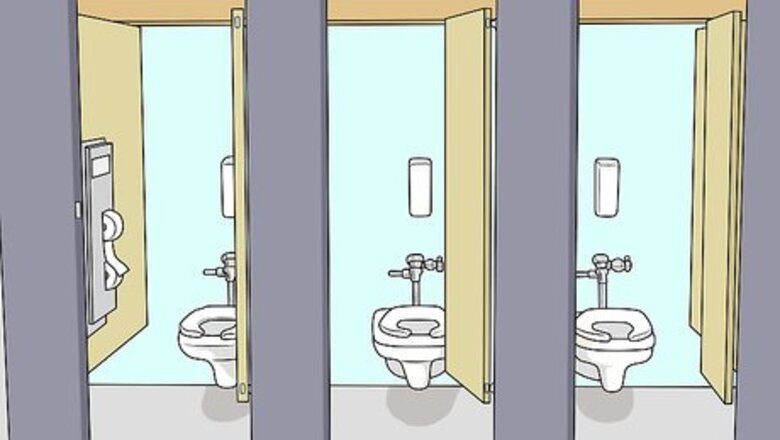
views
X
Research source
However, that doesn't mean you should throw good common sense out the window. To decrease your chance of contracting germs or just helping you feel more comfortable using a public restroom, there are a few tips to keep in mind.
Using a Public Restroom
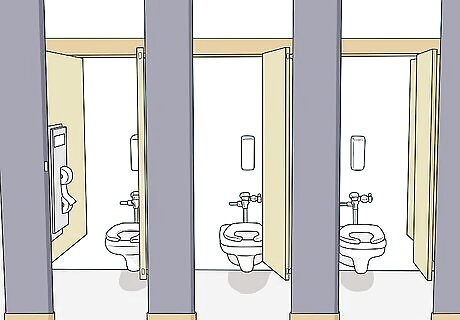
Look into multiple stalls. When you first enter a public restroom, take a quick survey of the available stalls. Make a smart choice on what stall to use. Choose a stall that seems the cleanest. The toilet should be flushed, the seat should be dry and free of any visible debris and there should be toilet paper and seat protectors. Many times one or two stalls may be visible dirty or contaminated. These stalls should be avoided if possible. If your only option is to use a dirtier or unclean stall, use more precaution and employ as many safe use practices as possible.
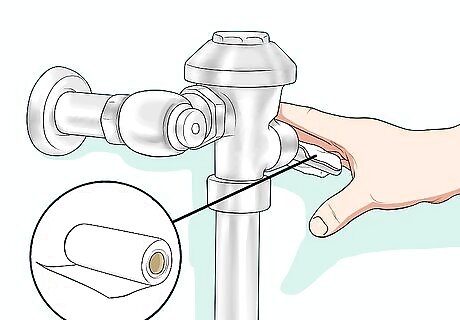
Flush safely. There is actually more chance of spreading bacteria or getting bacteria on you when you flush the toilet. Be careful and mindful when flushing public restroom toilets. When a toilet is flushed, the "spray zone" can be up to 6 feet (1.8 m). If you're in the stall and flush, you're right in the middle of that zone. Use toilet paper to touch the handle. Avoid using your bare hand to flush the toilet. Use some toilet paper or use your foot to flush. In addition, face away from the toilet when you flush. That way your face and mouth are not facing the toilet and will be away from the spray zone. Use toilet paper to open the door. It stands to reason that the inside latch of the toilet door is dirtier than the outside latch. Use a small piece of toilet paper to open it with and dispose of this paper immediately in the bin upon exiting.

Wash your hands. Washing your hands is probably one of the most important parts of using a public restroom. And unfortunately, many times the sink is the germiest place in the restroom. Wash your hands in the warmest water available or that is comfortable to you. The hot water helps sanitize your hands. Wash your hands using soap for at least 20 seconds under running water, (Happy birthday song twice).

Dry your hands appropriately. After you wash your hands, it's important to continue your safe hand washing practice with appropriate hand drying practices. You can still come into contact with germs when you're drying your hands. Ideally, the bathroom will have paper towels. If this is an option, also turn off the faucet with a paper towel. Use a separate towel to dry your hands and open the door of the bathroom to exit. Studies show that some hand dryers blow water back towards your face. In addition, other hand dryers catch water at the bottom of the drying unit and blow that collected water back up towards the user. If a hand dryer is the only method of drying your hands, follow the use of these machines by rubbing your hands with an alcohol-based hand sanitizer.
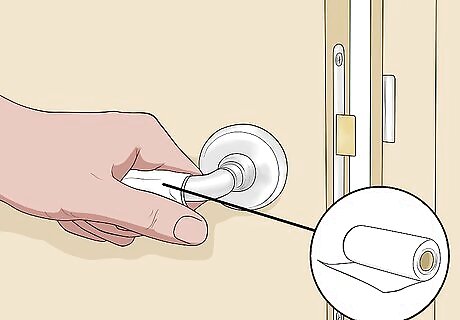
Leave the restroom safely. When you're leaving the restroom, you should still be wary of germs that you could come in contact with. Remember, although you washed your hands, others may not have. There is still a significant amount of germs on the door and handle of the restroom. Use a small square of toilet paper or hand-drying paper to open the door that leads out of the toilets. It may sound finicky but after all your hard efforts to wash your hands, continue without coming in contact with more germs. Also consider following up your bathroom break by using a hand sanitizer. This can help remove any additional germs you may have picked up.
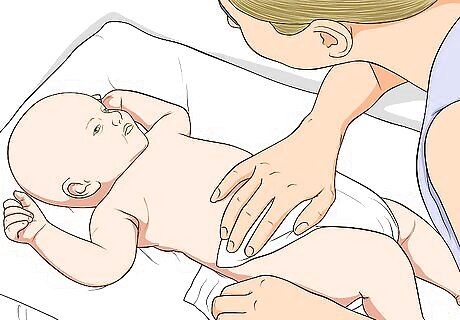
Practice safe baby changing techniques. If you're a parent/caregiver that has to change a baby's diaper in a public restroom, there are some additional precautions and tips to help keep the baby safe. Always have a changing pad and blanket with you. You can lay these down on the changing table, or if there isn't one, on a nearby bench or chair, or handicap stall. It may also be a good idea to keep extra wipes or baby approved sanitizers with you.
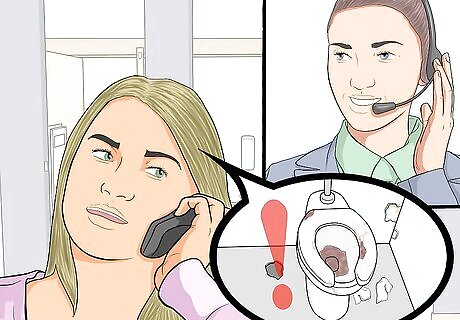
Tell management about poorly maintained restrooms/leaks. Most companies or local authorities are responsible for managing public restroom facilities and want to be told when their toilets are in disarray. Complaints from consumers do matter. Contact the building staff or appropriate management team and let them know that the restroom should be checked and cleaned. If you don't get a response or the standard doesn't lift, contact your local health department and lodge a complaint.
Planning Ahead for Public Restrooms
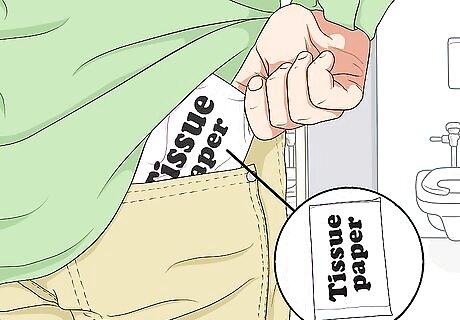
Bring your own toilet paper. Unfortunately, the toilet paper in public restrooms may not be as clean or safe as you think. Remove the first two layers of toilet paper to help reduce germs. Health experts say that when a toilet is flushed, some water and germs are sprayed into the air. This spray can be far reaching in the stall and can land on a variety of areas including the toilet paper. Removing the first two layers of toiler paper can help reduce how many germs you come into contact with. Throw them into the toilet before you sit down. You can also keep your own toilet paper in a plastic baggie in your purse or pocket so you do not have to use the paper provided in the bathroom.

Keep your own seat protectors. Studies have shown that although there are plenty of germs on the seat of the toilet, your skin is an incredibly effective barrier and keeps those germs from entering your body. However, using the seat protectors that are provided can help you feel better and safer when you sit on the seat. Again, when the toilet is flushed, the water and germs in the toilet can be sprayed on the provided seat protectors. Get rid of the first one available and throw away in the toilet. Many pharmacies and outdoor stores now carry tiny packs of toilet seat covers and it can't hurt to toss a pack into your handbag or backpack to take wherever you go.
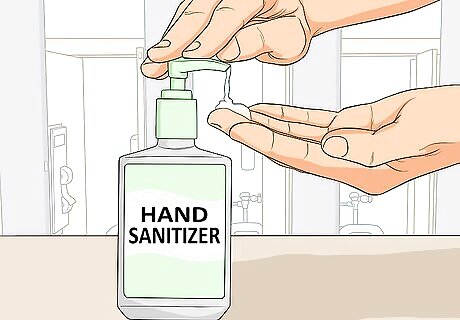
Bring alternate hand and body sanitation items. It might be a good idea to invest in some hand sanitizer to keep with you when you use a public restroom. You are not guaranteed to have safe hand washing facilities in public restrooms so having a back up plan is helpful. Carry a waterless hand sanitizer with you. You can use it after you've washed your hands and exited the rest room, for an extra precaution.
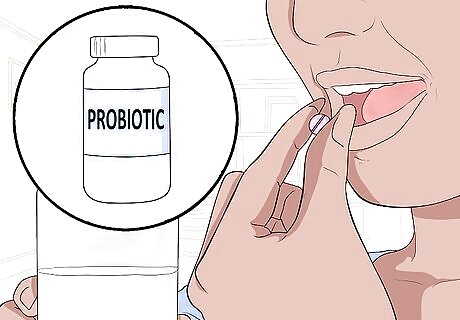
Take a probiotic. Although taking a daily probiotic isn't something you'd think would help with staying germ-free in a public restrooms, health experts actually think this can help. Studies have shown that the more beneficial and healthy bacteria or microbes you have in your gut, the better ability your body has to fight off foreign pathogens. Taking a daily probiotic might be helpful especially if you have to use a public restroom on a regular basis. Take a probiotic that has at least 10 billion CFUs (colony forming units) each day. This amount is generally contained in one pill or tablet.



















Comments
0 comment